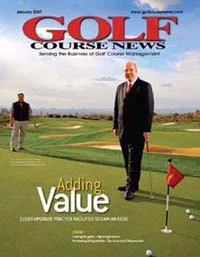Many golf course superintendents are no strangers to shrinking budgets and other restrictions that don’t allow them to care for the grounds to the extent they’d like. Sensing this is an issue on the forefront of turfgrass managers’ minds, the Ohio Turfgrass Foundation offered a day’s worth of seminars about economical turfgrass tending at its recent conference and trade show at the Greater Columbus Convention Center.
|
|
Titled “Managing a low to moderate budget golf course,” the session included turfgrass experts who presented cost-saving advice on several topics. A few of the highlights included:
1. Learn to calculate the most effective fertilizer treatment.
“Fertility is one of the key ingredients in a successful maintenance program and high-quality turf,” says John Street, Ph.D., from the Ohio State University department of horticultural and crop sciences, who spoke about calculating fertilizer costs and decision making.
Street says fertilizer programs are based on nitrogen, and the amount of nitrogen needed for a given maintenance program varies depending on course conditions. Once you determine the nitrogen need, calculating to find a low-cost yet effective nitrogen treatment is the next step. Street recommends the book “The Mathematics of Turfgrass Maintenance” by the Golf Course Superintendents Association of America.
Street says the most effective application schedule, especially in Ohio, is to apply 25 percent of the total amount of fertilizer for the year in the spring and 75 percent in late October or early November, or later in southern Ohio. He says this enhances spring green-up and encourages root growth.
2. Look for economical ways to change the golf course instead of springing for a full-fledged renovation.
Brian Huntley, an independent golf course designer from northeast Ohio, shared low-cost design changes that can dramatically change and freshen up the look of a golf course. First, Huntley suggests superintendents ask themselves if the trees on the course are serving their intended purpose? If there are trees that seem to be getting in the way of play, explain to the owners that trees are a detriment.
“Take the trees out – it will clean up the golf course immediately,” he says, adding it’s best to have the work done in the off-season because there’s less intrusion and the course members won’t be around to question the action.
Huntley also says it’s not necessary to provide five sets of tees at each hole.
“It’s OK to have blue and black on the same tee,” he says. “Try to get the tees to 35 by 35 feet so you can turn a triplex mower on it.”
Another economical change Huntley says can be made is eliminating some bunkers.
“For a course with 60 to 70 bunkers, you can back off to 40 to 45 if they’re in the right spot,” he says.
For instance, if there are two bunkers on the sides of a fairway, Huntley might recommend removing those and creating one bunker in the middle of the fairway and then widening the fairway for a fresh, different approach.
Huntley also suggests regularly making an effort to change the greens to resemble more closely their original size. They tend to shrink over time, he says.
If there remains a need for a major renovation on the course, educate the owners and/or master plan committee about what needs to be done and work with the committee to create a plan to gradually make improvements, Huntley suggests.
3. Take an economic approach to disease control.
This was the message from Joe Rimelspach, Ph.D., from the Ohio state University department of plant pathology. Rimelspach recommends turfgrass managers ask themselves what the goal for disease management is? From there, pick about two of the more prevalent problems and focus on treating them. The next step is researching the available options. A tool for preventing disease and a potential long-term money saver is turfgrass selection. Several cultivars of bentgrass have performed well in preventing disease, Rimelspach says.
Another ingredient to prevent disease is the practice of integrated turf health management. This includes the basics – fertility, mowing, aerating and irrigation – and making sure they’re practiced in the right quantity and frequency.
When the preventative measures don’t succeed in staving off diseases and some curative treatments are necessary, shop around, Rimelspach recommends. Calculate the cost of applying different treatments per 1,000 square feet to find the most economical approach.
4. Find a cost effective-approach to insect control.
Along with diseases, insect problems demand attention. Doug Richmond, Ph.D., of Purdue University’s department of entomology, offers some suggestions for cost-effective pest management practices.
As with diseases, identifying pest problems is the first step. Methods can include record-keeping, mapping, soil sampling or consulting with county agents or state specialists. Once there’s a list of pests to target, create a calendar to identify when these pests are in their various life cycles.
“Know what to look for on a monthly basis,” Richmond says.
This might allow you to choose one pesticide that has the ability to knock out two different pests at the same time once you’re in touch with the similar time frame in which they strike, he adds.
As with disease management, it’s important to promote root growth by irrigating and fertilizing. This should allow for judicious pesticide use.
“Let the natural controls do the work,” Richmond says.

Explore the January 2007 Issue
Check out more from this issue and find your next story to read.
Latest from Golf Course Industry
- From the publisher’s pen: Conscientious of a bigger role
- Bernhard and Company partners with Laguna Golf Phuket
- Terre Blanche showcases environmental stewardship
- VIDEO: Introducing our December issue
- Bernhard and Company introduces Soil Scout
- Nu-Pipe donates to GCSAA Foundation’s Centennial Campaign
- GCSAA enhances golf course BMP tool
- Melrose leadership programs sending 18 to 2026 GCSAA Conference and Trade Show






